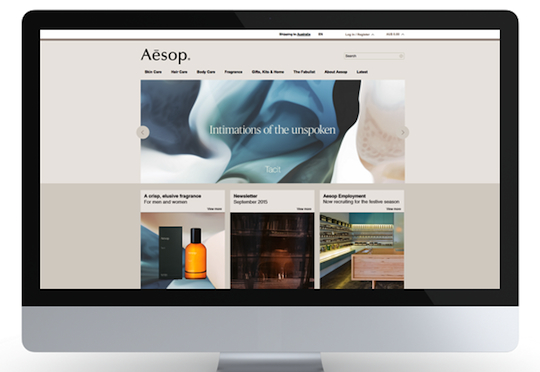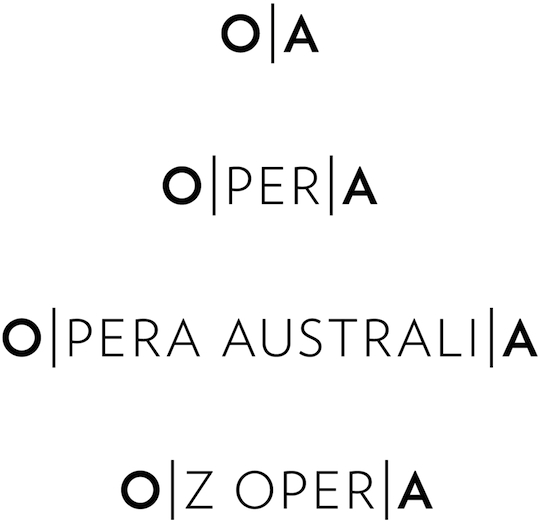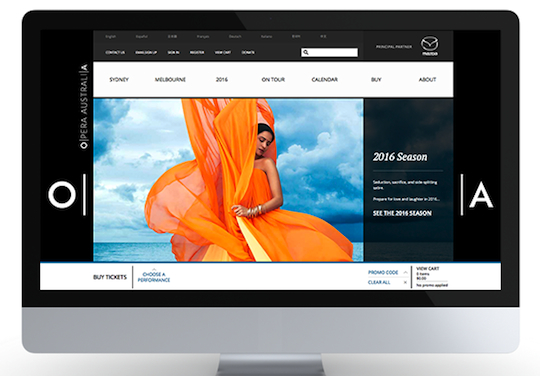Just do it, digitally: Branding in the digital age
Share
In the race to tick ‘website’ on the list of required channels, many brands are still forgetting that the principles of branding still apply to delivering a brand to an online audience. Jill Hale critiques the websites of four brands.
When it comes to delivering your brand to an online audience, the principles of branding still apply. It’s important not to consider your digital presence at the end of the branding or rebranding process. Make sure it’s regarded as a key part of the brand experience from the outset.
The quality divide between the execution of branding and its application to digital design is becoming increasingly wide. By this I mean, more than ever clients are appreciative of the branding process and understand that a brand is a business’s greatest commercial asset, but the website is managed as a future deliverable to be tackled down the line along with business cards and brochure templates.
Clients are engaged in the development of a well-crafted and seamlessly executed brand identity system and invest in the creative process employing experts in strategy and brand design. But at the completion of the branding exercise a website is launched without particular concern for the audience’s experience of the brand in this domain. While a brand is a business’s greatest commercial asset, the website is its most important marketing tool. So when it comes to prioritising the delivery of a statement-making business card or a statement-worthy website, a business should always choose the website.
Is your branding agency good at digital?
Perhaps the failure of clients to consider their website as king is the fault of those creative experts they commission to drive the branding effort. There are many agencies that do branding well (some extremely well) and digital execution terribly. By the same token, there are digital agencies that do websites and innovative digital applications exceedingly well, but when it comes to branding they should take a seat on the bench.
On 6 August, 2015, brand powerhouse FutureBrand announced its acquisition of digital agency Hugo and Cat. The addition of this digital clout to the roster of capabilities offered by a renowned branding agency attests to the recognition of a knowledge and skills gap within this agency, as well as the ever-increasing importance of branding in the digital age.
Patrick Smith, CEO of FutureBrand Worldwide, qualifies the strength of the acquisition: “It means reinventing branding in a way that reflects the new challenges our clients face as they grow and build brands in a rapidly changing digital world.” He goes on to give cause for the acquisition of Hugo and Cat as that the “rules that governed traditional branding have altered beyond recognition”.
Johannes Smith, one of the founders of Hugo and Cat, concluded that the intrinsic relationship with a brand agency provides “a compelling offer for global clients who know their success lies at the intersection of business, brand and digital experience.” The acquisition is undoubtedly a strategic move for FutureBrand to continue delivering across the length and breadth of branding.
These days everyone understands that a business or organisation needs a brand. Most people know that this brand needs an online presence, a website. Some people know that their website is the organisation’s most important marketing tool. But despite the importance of a well-designed, user-friendly website, organisations fail to prioritise the digital application of their brand.
Aesop: website lacks brand story
Aesop is one of the most impressive consumer brands in the world. The execution of the brand across various touch points is best-in-class, particularly in-store and product packaging. Aesop invests heavily on a store’s fit-out and visual merchandising to ensure the consumer experience is immersive and consistent from store to store.
Photograph by Houang Stephane. Image cropped.
However, the experience of the Aesop brand online leaves one feeling rather underwhelmed.
While the website is designed using visual language elements consistent with the brand guidelines, the brand experience is not as innovative or engaging as in-store, where the experience is always impressive and explores the use of space in new and interesting ways. The brand story is relatively absent from this online forum despite doing a fair job of constantly adding content to the ‘Latest’ section, which will encourage repeat visits.
Opera Australia: website fails to engage
Similar to Aesop, Opera Australia has a website that is not entirely befitting of the exceptional brand identity delivered to market by Interbrand Sydney in August 2013. The brand identity is sophisticated and contemporary, which heralds the use of photography to convey the emotion encouraged by each performance. Opera Australia’s brand application to above-the-line communications is elegant and dynamic, epitomising a world-class cultural organisation.
However, the website weakens this positioning to some extent with the brand applied to an interface design that doesn’t effectively extend the offline experience of opera.
The website design for Opera Australia doesn’t stack up against other brand touchpoints and while there are some good functional elements, the website simply serves a purpose of having an online presence. It does little to inspire engagement with the audience for more than purchasing tickets.
The implication of having an online presence that fails to support and extend on the brand positioning is that an audience has an inconsistent experience, which affects the perception of the brand. This is a lost opportunity for any business or organisation to remain connected to their audience in a digitalised world, especially considering that at some point in the customer journey they will always visit the brand website for one reason or another.
Nest: consistent and engaging
So, what makes a good online brand execution? Simply put, it’s when the audience’s experience with the brand online is aligned with the experience they have in the analogue realm. The brand purpose and personality must be adequately and accurately communicated through the online source, and the audience engagement consistent and positive.
Take Nest, for example. Nest is the innovator of home products, such as smart thermostat and smoke alarm devices controlled by mobile applications. This brand is inherently techie, savvy, uncomplicated and innovative; the experience of the brand online succeeds in reflecting this personality, as well as ensuring the user’s experience is seamless and the content engaging. Most importantly, Nest’s valuable consumer assets (the products) are presented with an intuitive understanding of what the audience will want to review, learn, test and understand, all leading to an online transaction.
Frank Body: progressive, dynamic and authentic
Probably one of the best examples of branding in the digital age is Frank Body. From its humble beginnings as a disrupter via social media, the cheeky and youthful Frank Body completes its online existence through a captivating website that’s representative of the brand’s personality and market positioning. The design is progressive, the content is dynamic, the language is cute, the product looks good (all over the bodies of very pretty people), and the overall engagement is authentic without being contrived. Given that Frank and Nest are primarily ecommerce businesses, it’s fairly critical that their key source of revenue is always treated as a brand priority with ongoing review of, and investment in this online tool a requirement.
The wrap
The core message is this: a business shouldn’t consider its website as just another marketing tool, but as THE marketing tool and invest accordingly. When developing the brand identity, it should be made certain that the application of the brand to a digital format is considered as a priority. It is wise to start planning for the website during the infancy of the brand strategy phase and make sure the creative agency can rationalise the branding with respect to both online and offline environments.
Before and after the website is live, a business should ensure the content is considerate of the experience it wants its audience to have with the brand and not simply add everything to the website and hope the users bother to search through pages and pages to find what they need. Updating website content often and keeping it up-to-date is imperative; it shouldn’t be allowed to become stale by keeping Christmas trading details live up until Easter.
Of significant help is reviewing the website’s web analytics data and responding to what the numbers are revealing by removing information that no one’s engaging with and prioritising the content that they are engaging with. If a business has a blog, or a ‘news’ section, it’s important to post on it frequently, not every other month. If there are multiple contributors developing content for the website, it’s good to ensure they are inducted as a brand guardian and truly understand how the brand looks, talks and acts with respect to the audience.
Simply put, when it comes to delivering a brand to an online audience, the principles of branding still apply – stand out and own a position; engage with your audience (have a conversation and respond to their needs); remember less is more; be consistent; and keep looking forward.
Jill Hale is brand and strategy director at Yoke.





















